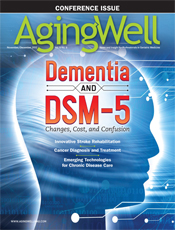
November/December 2012
Elevated TSH Levels:
To Treat or Not to Treat?
By Juliann Schaeffer
Aging Well
Vol. 5 No. 6 P. 6
Physicians are accustomed to checking thyroid-stimulating hormone (TSH) in older adults with symptoms of an over- or underactive thyroid, as it’s a fairly accurate and routine measure of thyroid function. But a new study suggests that for many patients, treatment for mild TSH elevations may no longer be warranted.
“As increasing numbers of people live into their 80s and 90s, it is important to know how to manage their health, including thyroid function,” says Anne Cappola, MD, ScM, an associate professor of medicine at the Perelman School of Medicine at the University of Pennsylvania and lead study author. “We sought to describe what happens to thyroid function in older people over time and to determine the relationship between thyroid function and mortality in this population.”
The study, accepted for publication in The Endocrine Society’s Journal of Clinical Endocrinology & Metabolism, questions the assertion that slightly elevated TSH levels are linked to an increase in mortality and suggests that such elevations may actually be a normal part of healthful aging.
Study Particulars
The study first examined 5,888 men and women aged 65 and older between 1989 and 1992. Then in 2005, researchers reexamined 843 surviving participants’ thyroid function for any changes in physical and cognitive function. Study participants ranged in age from 77 to 102, with a mean age of 85.
“We found that levels of TSH gradually increase during the aging process, which means that more older people are outside of standard reference ranges and could be labeled with the diagnosis of subclinical hypothyroidism,” Cappola says. “However, older people [mean age of 85] with subclinical hypothyroidism did not have a higher death rate and, if anything, there was a suggestion that having subclinical hypothyroidism was protective.
“In addition, higher levels of thyroid hormone itself were associated with a higher risk of death,” she adds. “Gradual increases in TSH have been shown in younger populations, and it was gratifying to be able to extend these longitudinal findings into our older population. Based on our work and those of other groups, we hypothesized that subclinical hypothyroidism would not be associated with mortality. Ours is the largest study in older people to show this.”
Cappola says elevated TSH levels are relatively common in older adults, seen “in approximately 15% of US adults aged 65 and older, and it’s more common in women than in men,” she says, noting that previous research suggests it becomes more common in patients in their 70s and tends to run in families.
When to Treat
Cappola notes that older adults with only a mild elevation in TSH are unlikely to see their levels progress to a dangerous level. “We have shown in previous studies that the mildly elevated TSH level tends to persist or revert to normal and rarely progresses to a dangerous level. Others have shown an annual rate of progression of 2% to 4%,” she says.
What are considered mild vs. extreme in TSH increases? According to Cappola, her research regarded mildly elevated TSH levels as those in the 4.5 to 7 mU/L range, while very elevated TSH levels were considered to be those greater than 20 mU/L. “The 7 to 10 and 10 to 20 mU/L ranges are somewhat gray zones,” she says, “but most would treat persistently elevated TSH levels in this range, regardless of the patient’s age. The treatment is thyroid hormone replacement with levothyroxine.”
While Cappola stresses that very elevated TSH levels are a separate matter altogether and still need to be treated, she notes that milder increases haven’t yet shown to be a risk to older adults’ health. “There are serious risks to not treating very elevated TSH levels,” she explains. “Our research group is looking for risks to leaving mildly elevated TSH levels untreated in older adults, and we have not found any so far.”
“An important point is that for elderly patients, and increasingly as the patient ages, doctors need to think carefully about both the indications and ramifications of any treatment,” notes Rosemary Laird, MD, MHSA, AGSF, medical director of the Health First Aging Institute and past president of the Florida Geriatrics Society.
“Certainly, with subclinical disease there is no perceived loss of quality of life, so treatment of any kind should be carefully considered. For clinicians, these results support watchful waiting and serial reassessment for most older adults with only mildly elevated TSH levels. It even suggests some evidence of potential harm from higher levels of thyroid hormone, so all the more reason to carefully choose one’s response to mildly elevated TSH,” she posits.
“We can also use this [study’s findings] as a reminder that geriatric care needs to be care that is individually tailored and reactive to an individual’s overall quality of life and life expectancy, since both of these foundational pieces of information make the difference in clinical decision making,” Laird adds.
It is Cappola’s hope that these findings take hold in the clinical community, prompting geriatricians and primary care physicians to think twice before treating their much older patients for such mild elevations that, in her opinion and from recent evidence, prove unlikely to do any harm on their own while focusing instead on those with more aggressive leaps in TSH.
“Our study shows that a gradual increase in TSH occurs during healthy aging and that mild increases in TSH are not harmful in the oldest old,” she says. “Beyond that, we found that higher levels of thyroid hormone are associated with increased mortality. These findings raise concern for reflexively treating older people with mild elevations in TSH with thyroid hormone replacement.”
— Juliann Schaeffer is an associate editor at Great Valley Publishing Company.
| 
![]()

![]()